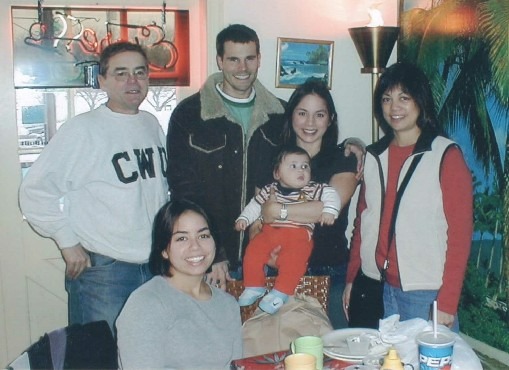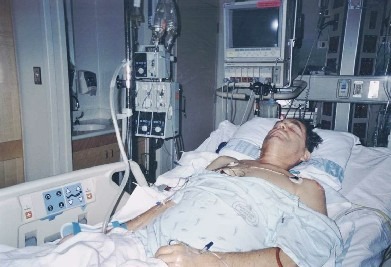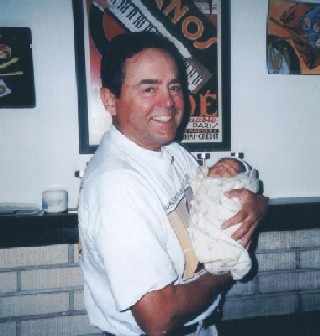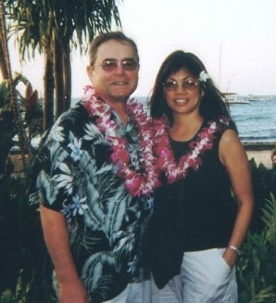Looking Forward To "Retirement Ruts"
After 40 years of dedicated work, Peter Galassi was looking forward to being in "kind of a rut where you have all the time in the world to get those little things done." Peter was just 58 years old when he retired in January of 2004. Peter assumed that he still had plenty of time for all the postponed household remodeling projects, vacations, and other joys of retirement he had planned with his wife Louise. After all, both of his parents were still living and healthy.
Peter's father, age 89, assured Peter that he would most likely live to be in his late 80's and early 90's, just like his parents and grandparents. The elder Galassi, complaining of his aches and pains declared, "Well, you know, I felt pretty good until I was 80." With this knowledge of family longevities, Peter fully expected 20 years plus another ten on top of those.
Peter and Louise spent the last few weeks of Winter 2004 romping around the Southwest. In June they became the proud grandparents of their first born grandson, Austin Peter. After Peter's daily ritual of pushups and sit-ups followed by walking five miles, he would spend the remainder of his day doing household chores, clearing the drain gutters, pruning the trees, gardening, sometimes cooking or pestering his "better half" of 38 years. Peter had no complaints.
While vacationing at Lake Tahoe during the first part of August 2004, Peter noticed he had a little trouble breathing when he was on the tennis court. He attributed his shortness of breath to the change in the altitude and spent the rest of the vacation taking it easy. When Peter returned home the second week of August, he tried to resume his daily five-mile walk but in Peter's words, "I had trouble pulling a hill." This time he thought it might be allergies slowing him down. Louise suspected more and urged him to go to the doctor.

![]()
A chest film, taken by his primary care physician, revealed a large right-sided pleural effusion. On August 17, 2004, after being referred to a pulmonologist, he underwent a right chest thoracentesis where two liters of blood-tinged fluid was drained from the space between the lung and the pleural lining. The fluid had forced his lung to close, causing his shortness of breath. The pleural fluid was sent to the laboratory for testing. Peter returned a week later to learn the results of the tests. The pulmonary specialist indicated that a number of the atypical cells identified were highly suspicious for an epithelial neoplasm, or cancer. A repeat thoracentesis, along with a pleural biopsy on August 23, 2004, returned a diagnosis of epithelial mesothelioma. Dr. Samuel Hammar, a member of the U.S.-Canadian Mesothelioma Panel and highly respected pathologist, performed the diagnostic evaluations for both procedures. The pulmonologist referred Peter to an oncologist who stressed the urgency for immediate treatment.
After being told of the diagnosis, Peter's first reaction was that of shock and disbelief! Why me? He believed himself to be in good health. After all, he watched what he ate, exercised and had a strong heart. Once he mustered his thoughts, he scoured the Internet looking for all the information he could find on treating mesothelioma. Peter wanted to know up-front all the medical options and treatments that were available. Peter and Louise worked together and decided to launch a full-scale attack!! That search confirmed the decision to contact Dr. Eric Vallieres, at the Swedish Cancer Institute in Seattle, Washington. Dr. Vallieres, a specialist in thoracic surgical oncology and the surgical director of the Lung Cancer Program at the Institute, is also known to be a true patient's advocate.

![]()
Dr. Vallieres consulted with Peter in early September, 2004. After his examination and review of Peter's medical records, Dr. Vallieres discussed all the available treatment options. Peter understood but wasn't ready to throw in the towel. Dr. Vallieres suggested a multi-modality regimen which included induction chemotherapy, a right-sided extra-pleural pneumonectomy (EPP) and adjuvant radiation treatments.
Peter began chemotherapy immediately. He received induction Cisplatin and Pemetrexed (Alimta) chemotherapy and completed his four cycles on November 5, 2004. Then, it was back to Dr. Vallieres' office for a complete battery of pre-operative tests to determine whether he remained a suitable candidate for the EPP. The tests included a CT scan, which on November 23, 2004 exposed some residual fluid on the lower right side. A mediastinoscopy was performed on December 3, 2004 to substantiate the staging of the tumor and any invasion of the lymph nodes. Dr. Vallieres planned to drain the residual fluid seen on the November 23 CT scan and insufflate talc powder into the pleural cavity. However, the thoracoscopy was aborted after finding that the tumor-involved pleura was completely fused to his chest. Even though Dr. Vallieres was not able to prepare the pleural cavity as he had planned, the two lymph nodes biopsied during the mediastinoscopy were negative. This was great news because it meant that Peter was still eligible for the EPP.

![]()
During the December 13, 2004 surgery, Peter's entire right lung, sections of the diseased diaphragm, a portion of the adherent pericardium and pleura were removed. The pathological analysis of the tissue removed during the surgery confirmed the diagnosis of malignant epithelial mesothelioma. Unfortunately, two of the lymph nodes taken during that surgery were found positive for metastic mesothelioma invasion.
After almost seven hours of surgery, Peter had an anxious group of family and friends holding vigil in the waiting room. By the fourth day, Peter was moved out of ICU and into a room that was soon flooded with comforting friends. The next few weeks of recovery went by quickly and by the middle of February Peter was ready to begin the adjuvant radiation treatments. The treatments were five days a week for six long grueling weeks. The exhaustion Peter experienced was overwhelming. But with Louise's strength and resilience Peter continued their plan of attack.
Today, Peter no longer walks his five mile trek. He states he's lucky if he can walk a mile in an hour. He has no stamina. Peter feels empty, like there's something sloshing around or Jell-O that has not yet set. If he lies on his left side too long or moves too quickly, he becomes nauseated. But Peter quickly adds that his concerns are not so much about his health but about those that he will someday have to leave behind. His wife is wondering what will become of Robert Browning's " Grow old along with me the best is yet to be." His daughters were also looking forward to spending more time with their dad and Peter was relishing the thought of spending as much time with his grandson, Austin Peter, as well as future grandchildren. And just how much time does he have to get those little things done? Bottom line, he is not a quitter....he is a survivor!
POSTED MAY 4, 2005 ***
Mr. Peter Galassi passed away on July 8, 2005
UNITED STATES DISTRICT COURT
NORTHERN DISTRICT OF CALIFORNIA
Case No. C 05 02017 WHA
(State Court Case No. CGC-04-436144)
PLAINTIFFS' MOTION TO RETAIN JURISDICTION FOR THE LIMITED PURPOSE OF ASSESSING SANCTIONS UNDER THE COURT'S INHERENT POWERS SHOULD PLAINTIFF DIE BEFORE TRIAL
Come now plaintiffs and file this motion to retain jurisdiction for the limited purpose of assessing sanctions under the Court's inherent powers should plaintiff die before trial, and would respectfully show the Court as follows:
As the Court is aware, Mr. Galassi is dying of mesothelioma. In view of his exigent condition, pursuant to California Civil Procedure Code §36, plaintiffs' case was set for trial in state court on June 14, 2005. That trial date was lost because of the removal of the case to this Court. As the Court found in its Order Remanding Case and Vacating Hearing, "[i]ndependent of the questionable timing, Warren Pumps' removal of the action was wholly unnecessary, meritless and obviously an attempt to delay plaintiffs' upcoming trial date." Order at 5.
In view of the lack of merit in the removal and its clear motive, the Court also held that an award of attorneys' fees and costs is warranted pursuant to 28 U.S.C. §1447(c). In a separate order, the Court set forth a procedure for determining the amount of fees and costs to be awarded. Pursuant to that order, plaintiffs filed their submission on June 24, 2005.
The present motion requests the Court to retain jurisdiction for the purpose of preserving the ability of plaintiffs to seek an award of additional sanctions under the Court's inherent powers. As detailed below, if Mr. Galassi dies before trial, plaintiffs will lose a very significant element of recoverable damages -- his pain and suffering before death. This was the true motivation for the removal. While plaintiffs of course hope this will not happen, and are working strenuously to obtain a trial as quickly as possible, plaintiffs respectfully request the Court to retain jurisdiction to assess sanctions under its inherent powers if necessary.
I. IF MR. GALASSI DIES BEFORE TRIAL, THERE IS NO RECOVERY FOR HIS PAIN AND SUFFERING
As the Court knows, mesothelioma victims have a life span measured in weeks or months, not years. Mr. Galassi was diagnosed with mesothelioma in the summer of 2004, and unfortunately has, in all likelihood, only a few weeks or months left to live. It was upon such a showing that plaintiffs' case was granted preference under §36 and set for trial on June 14, 2005.
If Mr. Galassi dies before trial, there is no right of recovery for his "pain, suffering or disfigurement" on the part of his survivors. Cal. Civil Proc. Code §377.34. Indeed, this would be true even if Mr. Galassi makes it through a trial, but dies before judgment is entered. Kellogg v. Asbestos Corp., 41 Cal.App. 4 th 1397, 1407 (1996), rev. denied. This element of damages is significant. "[M]esothelioma victims invariably suffer great pain and disability." Georgine v. Amchem Prods., Inc., 83 F.3d 610, 633 (3d Cir.), aff'd, 521 U.S. 591 (1997). As Justice Kennedy put it:
One who has mesothelioma, in particular, faces agonizing, unremitting pain in the lungs, which spreads throughout the thoracic cavity as tumors expand and metastasize. See W. Morgan & A. Seaton, Occupational Lung Diseases 353 (3d ed. 1995). The symptoms do not subside. Their severity increases, with death the only prospect for relief. And death is almost certain within a short time from the onset of mesothelioma.
Norfolk and Western Ry. Co. v. Ayers, 538 U.S. 135, 168 (2003) (Kennedy, J., concurring).
Mr. Galassi was diagnosed with mesothelioma in the summer of 2004, and so he will die in a matter of months.
Thus, if Mr. Galassi dies before trial, his survivors will lose a substantial element of damages. Put simply, the baseless removal will still have been worth it to Warren if this occurs. Even if Warren pays the entire amount requested by plaintiffs in fees -- just over $33,000 -- Warren still will have avoided exposure to a claim worth hundreds of thousands or millions of dollars. [1]
Plaintiffs are doing everything in their power to get the case to trial as quickly as possible, and of course hope that a trial occurs before Mr. Galassi dies. On June 22, plaintiffs' counsel appeared in state court to request that the case immediately be restored to the trial calendar. Predictably, counsel for Warren and other defendants argued against the request. The state court has ordered the parties to return on June 28, at which time the case will likely be assigned to a single judge who will resolve all procedural issues and will then, at some point, return the case to the Presiding Judge for assignment to the trial department. See affidavit of Jeffrey Kaiser, attached as exhibit B.
In sum, plaintiffs are doing everything possible to move the case to trial; Warren and other defendants are resisting. We hope a trial will occur while Mr. Galassi is alive, but it may not.
II. AS AN EXERCISE OF ITS INHERENT POWERS THE COURT HAS THE POWER TO AWARD, AS A SANCTION, THE LOST ELEMENT OF DAMAGES
It was not possible to file a motion for sanctions under Rule 11 in this case, as such a motion requires 21 days advance notice. Moreover, once the Court granted plaintiffs' motion for remand, a motion under Rule 11 was effectively mooted. Truesdell v. Southern Calif. Permanente Group, 293 F.3d 1146, 1151-52 (9 th Cir. 2002); Barber v. Miller, 146 F.3d 707, 710-11 (9 th Cir. 1998). The Court is, however, free to award sanctions for bad faith conduct under its inherent powers. Chambers v. Nasco, Inc., 501 U.S. 32, 48-49 (1991). While the Court has already ordered an award of attorneys' fees, an additional sanction, in recognition of sums lost by plaintiffs as a result of a wrongful removal, is within the Court's power. Davis v. Veslan Enterprises, 765 F.2d 494, 501 (5 th Cir. 1985). The Court may retain jurisdiction, after the case has been remanded to state court, for purposes of considering such an award. Moore v. Permanente Med. Group, Inc., 981 F.2d 443, 445 (9 th Cir. 1992).
III. THE COURT NEED NOT RESOLVE THIS MOTION NOW, BUT IT IS FILED TO COMPLY WITH THE LOCAL RULES
This motion will be moot, of course, if Mr. Galassi survives through the time of trial and entry of judgment. While plaintiffs have noticed a hearing date of August 18, 2005, this date of course may be continued, and plaintiffs would agree that defendant need not respond to this motion unless and until it becomes ripe. In an abundance of caution, however, plaintiffs have filed the present motion within 14 days of the Court's order remanding the case to state court. Local Rule 54-6 provides that a motion seeking an award of attorneys' fees must be filed within 14 days of entry of judgment. While the present motion would not seek an award of attorneys' fees, and while an order remanding a case to state court is not an entry of judgment, plaintiffs believe that the broader intent of this Local Rule is that motions seeking relief of this type are to be filed within 14 days of the district court's final disposition of a matter. Plaintiffs emphasize again that they are asking only that jurisdiction be retained for this limited, conditional purpose, and that defendant need take no action in response unless and until this motion becomes ripe.
WHEREFORE, PREMISES CONSIDERED, plaintiffs respectfully pray that the Court retain jurisdiction over this matter for the limited purpose of considering an award of sanctions, under the Court's inherent powers, if Mr. Galassi dies before the trial of the state court action.
DATED: June 27, 2005
[1] To give one recent example, in Treggett v. Alfa Laval Inc., et al., No. BC-307-508, another mesothelioma case, a jury in Los Angeles County awarded the plaintiff $12,000,000 in noneconomic damages, in addition to substantial awards for economic damages and punitive damages. Defendant's motion for new trial was denied and the case is on appeal. The judgment is attached as exhibit A. While this award is larger than most, it demonstrates the substantial nature of this element of damages. Plaintiffs propose to establish a value for this element by introducing evidence of typical awards and settlements in like cases.

